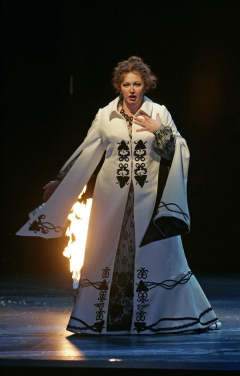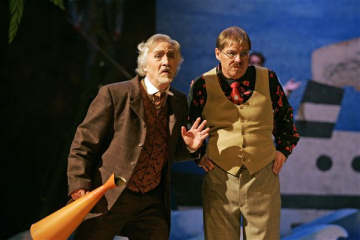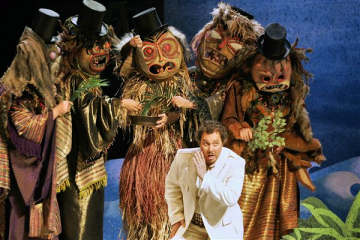|
Editorial Board
Melanie
Eskenazi
Webmaster: Len Mullenger
|
Seen and Heard International
Opera Review
Mikko Heiniö 'The Hour of the Serpent' (Käärmeen Hetki) : (new production) Soloists, Chorus and Orchestra of Finnish National Opera, Hannu Lintu (conductor) Helsinki 23.09.2006 (BK)
Päivi Nisula as Alice Löf
Cast
Jonas Löf, a scientist explorer: Juha Riihimäaki Alice Löf, Jonas's
wife : Päivi Nisula Ida, Alice Löf's
Maid: Piia Komsi A music conductor:
Tom Nyman
Finnish National Opera's
habit of commissioning a completely new Finnish work each
year is a laudable and courageous activity, particularly
in times of economic constraint. Last season there was
the children's opera Suomalainen Tapiiri (The Finnish
Tapir) by Jouko Linjama and before that we had Saariaho's
L'Amour de Loin and Rautavaara's Rasputin.
Most of these new productions have large casts and elaborate
sets and Mikko Heiniö's second opera, Käärmeen
Hetki or The Hour of the Serpent runs
true to the tradition.
The story is elaborate and multi-layered. Alice Löf's husband Jonas is a herpetologist who has disappeared for some years, apparently lost on an exploration in the 'Antipodes.' All that Alice has left to her are Jonas's incomplete travel journal and her memories. She has become a 'companion' to the rich industrialist Baron von Schiele and lives in his home along with his two sisters and her maid. Alice is loved in different ways by the Baron (who wishes to marry her), by the apparently kindly Professor Huldén and by a young scientist called Erik Aronius: each of them tries to define her in his own terms.
Alice resists. Instead of submitting to the men's views she chooses to define herself by means of her memories of her husband (he is the 'serpent' in the opera's title, she says) and in terms of fantasies she entertains about being lauded by the members of the local Scientific Society - an all male organisation. She believes for example (or perhaps it is true) that she is the subject of a hymn of praise sung by the society's members at their annual soirée.
Esa Ruuttunen as von Schiele (left)
It is important to Siltanen to set the story in the late 19th century. At that time, he says, men were conquering nature as never before; the first moving pictures were being made, electricity began literally to light up the world and exploration of the human sub-conscious began. (Breuer and Freud's 'Studies in Hysteria' containing the case study of the famous Anna O who was cured of paralysis after recalling cradling her dying father in her paralysed arm, was published in 1895.)
Huldén, von Schiele and Aronius attempt to console, comfort or 'cure' Alice's emotional state in various ways. Huldén has manufactured her husband's 'journal' as a consolation for her, von Schiele believes that he can persuade her to move on emotionally by engaging with the wonders of the cinema and electric technology and Aronius tries to face her up with the 'truth' that she is hanging on only to fantasy. Like Zuleika Dobson's would-be lovers in Max Beerbohm's novel, both von Schiele and Aronius die enraptured by Alice's fatal attraction. In the final scene of the opera, Huldén and Alice are in Paris at a smart cafe. Jonas Löf arrives from St. Petersburg, neither deceased nor lost but fleeing (perhaps) from the incurably hysterical Alice. It is likely that Alice has known the truth all the time, since a letter from Löf written in St. Petersburg, was accidentally left inside 'his' journal.
Mikko Heiniö describes himself as post-expressionist. He says that a respect for the listener's prior experience and the desire to touch listeners intellectually and emotionally are the guiding factors in his extensive output. The musical nucleus of this opera is a seven-note chord, out of which Heiniö teases both explosive and lyrical moments. The opera has been described as cinematic, and Heiniö says that he composes musical ‘images’ arising from the libretto.
The result has many moments of extreme beauty, informed as Heiniö freely admits, by allusions to other classical composers, Finnish folk song and German schlagermusik. Reminiscences of Bartók, Schoenberg and Janácek can also be detected and there is no doubt that this is a competent, carefully considered and interesting score, ably conducted by Hannu Lintu and elegantly sung by the extensive cast and chorus.
Despite sumptuous sets, lighting, costumes and special stage effects however - the Act I fire is created by a combination of back-projected video and an enormous red satin 'flame' that billows out from the stage to pass over the heads of the audience - the plot is so complicated and self-referential that the beauties of the score and singing are lost to some degree, certainly after only one hearing. Other compositional quirks remain baffling too. Why, for instance, does so much of von Schiele's music require him to sing a quasi - falsetto phrase at the end of his more normal bass-baritone vocal lines? Without having good Finnish, this is hard to make sense of and the consequence is that this (and similar) musical puzzles distract attention from the score's onward flow.
The singing is uniformly fine however - Heiniö knows how to write for voices - and Päivi Nisula (Alice) Jyrki Korhonen (Huldén) Juha Riihimäki (Löf) and Esa Ruuttunen (von Schiele) are all in exceptional form. As a new experience though, this opera lacks the immediate and lasting impact of Rasputin or L'Amour de Loin and I came away from it feeling that it needs simplifying drastically à la Bluebeard's Castle or Erwartung. As a study of the female psyche (or of truth, self-deception and falsehood for that matter) it takes more than one 'analytic' session to fathom: and as cinema (to which the opera pays great homage) it needs some serious cutting.
Back to the Top Back to the Index Page |
| ||
|
||||





